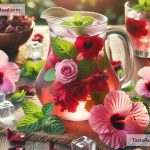How to Brew a Classic English Breakfast Tea
Ah, English Breakfast Tea! It’s like the comfort food of beverages. This robust and hearty brew has captured the hearts of tea lovers around the world. But, brewing it the right way? That’s where the magic truly happens. Whether you’re a devoted tea aficionado or a newcomer to the world of teas, let’s spill the tea on how to brew a classic English Breakfast Tea.
What is English Breakfast Tea?
Before we dive into the brewing process, let’s quickly talk about what English Breakfast Tea actually is. Originating from the United Kingdom, this tea is a blend of various black teas from Assam, Ceylon, and Kenya. Its strength, bold flavors, and energizing properties make it a perfect start to the day, thus earning its name ‘English Breakfast Tea’.
What You Need
- English Breakfast Tea (loose leaf or tea bags)
- Fresh, cold water
- A kettle or a pan to boil water
- A teapot or a mug
- A tea strainer (if using loose leaf tea)
- Milk, sugar, or lemon (optional)
Brewing the Perfect Cup
Here’s how you can brew a delicious cup of this classic tea.
1. Start with Fresh Water
The water you use is crucial. Always opt for cold, freshly drawn water from the tap. The oxygen in the water contributes to a fuller tea flavor. Avoid reboiling water, as it loses oxygen and can make the tea taste flat.
2. Boil the Water
Heat your water until it reaches a rolling boil. For the best results, use a kettle. If you don’t have one, a saucepan will do. Once the water has boiled, allow it to cool for about a minute. This brings the temperature to around 200°F, which is ideal for black tea brewing.
3. Preheat Your Teapot or Mug
This step is often overlooked but makes a world of difference. Pour some hot water into your teapot or mug, swirl it around, and then discard it. This preheating prevents the steeping water from cooling too rapidly once it contacts the cold ceramic or glass.
4. Measure Your Tea
If you’re using loose leaf tea, use about one teaspoon of tea leaves for each cup of water. For tea bags, one bag per cup is just fine. Place the tea leaves or bag into your teapot or mug.
5. Pour and Steep
Pour the hot water over the tea or into the teapot. Make sure to cover the leaves completely. Allow the tea to steep for about 3-5 minutes. The steeping time can vary depending on how strong you like your tea. As a general rule, 3 minutes gives you a fairly strong cup, but if you prefer a bolder flavor, let it steep a bit longer.
6. Remove the Leaves or Bag
After the steeping time is up, remove the tea leaves or bag. If you’re using loose leaf tea, use a strainer while pouring the tea into a mug.
7. Customize Your Cup
English Breakfast Tea is versatile when it comes to additions. You can enjoy it plain or add milk, sugar, or lemon according to your preference. If you’re adding milk, pour it into the cup before the tea to prevent the milk from curdling.
Tips for a Perfect Brew
- Water Quality Matters: The better the water, the better the tea. If your tap water tastes off, consider using filtered or bottled water.
- Adjust Strength to Taste: Experiment with steeping times to find your perfect brew strength. Everyone’s taste is different.
- Storage is Key: Keep your tea in a cool, dark place in an airtight container to preserve its flavors.
Conclusion
Brewing a classic English Breakfast Tea is both an art and a science. But don’t let that intimidate you. With these simple steps and a bit of practice, you’ll be brewing the perfect cup in no time. Remember, the essence of tea brewing lies in the details—water quality, temperature, and steeping time. Customize it to your liking, and savor the moment. After all, a good cup of tea is not just about taste—it’s about the experience. So, put the kettle on, and let’s make every day a little more tea-rrific!


